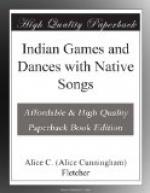Refrain: Ho-o! Ho-o! Ho! Ho! Ho!
[Music]
As each “Ho-o!” of the refrain is sung, the dancers should whirl like merry sprites, twine and untwine their green mantles about their forms until the song begins again. Then they should all skip off with springing, rhythmic steps in open Indian file, letting their mantles float and wave about them as they wind in and out over the camp ground carrying “Youth and Hope ev’rywhere.” Every time the refrain is reached, the dancers should stop and whirl, then as the song begins again move off in line, dancing as before. When they are ready to stop (that can only be done during the singing and whirling of the refrain), each dancer should whirl from the line and keep up that movement, singing “Ho!” until his or her tent is reached.
DANCE II
Introductory note.—The rituals and ceremonies from which this dramatic dance with its accompanying songs are taken have been handed down through numberless generations. They deal with the perpetuation of the vocations of the people and also with the duties of the warrior, who must so protect the people that these vocations can be pursued in peace and safety. The portion of the ritual that relates to the planting of the maize is here given. It is practical in character. The ground is to be cleared of the debris of winter’s storms and the dead leaves and twigs gathered into heaps and consumed by fire. When the brown earth is uncovered on the sunny slope it is to be mellowed and made into little hills with flattened tops to receive the kernels of the corn. The first seven of these hills must be ceremonially planted. Into the first hill one kernel of corn is dropped, two kernels are put into the second hill, three in the third, and so on to the seventh, in which are placed seven kernels. The product of these seven little hills must be kept separate, for it is to constitute the “first fruit offering” made to Wakon’da, through the priest, in recognition of the gift of corn as food. After the seven hills are completed, then the rest of the field is similarly prepared and planted. When the kernels are put in the loosened ground they are covered and stamped with the foot, so that each little hill beards the mark, the footprint, of the planter. The Ritual Song depicts the task of planting to its completion and compares the rows of little brown hills to lines of buffalo following one another down the slope. With this vision, suggesting the promise of abundant food, the workers joyfully turn toward the home fireside.
The words given for the first song are a brief paraphrase of the many stanzas of the original Ritual Song, which so touches the necessary acts of the planter as to lift them above a merely prosaic level.




